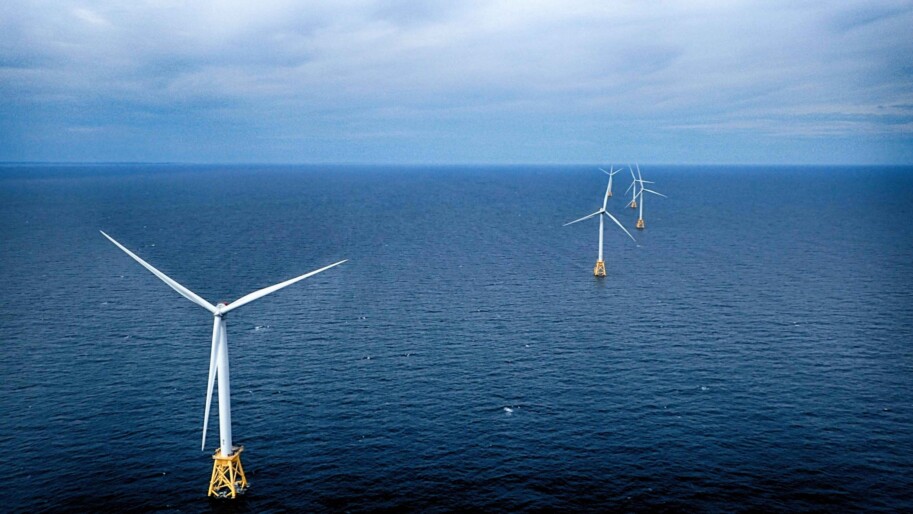Massive new projects put New England states on the forefront of the U.S. offshore wind market. May 23, 2018
By Jeff St. John and Julia Pyper
Massachusetts and Rhode Island, two states on the forefront of the nascent U.S. offshore wind market, have awarded a combined 1,200 megawatts of contracts to build out what could become the country’s largest offshore wind complex.
On Wednesday, Massachusetts announced that Vineyard Wind, a project backed by Iberdrola’s Avangrid Renewables and Danish investment firm Copenhagen Infrastructure Partners, had won a contract to build up to 800 megawatts of wind turbines off the coast of Martha’s Vineyard. The consortium beat out two other contenders, Bay State Wind and Deepwater Wind, which also hold leases on the stretch of windy coastline.
This is the first contract to meet a goal set by Massachusetts lawmakers in 2016 to build 1.6 gigawatts of offshore wind power by 2027. Vineyard Wind expects to have the wind farm operational and selling power to Massachusetts utilities by 2021.
Also on Wednesday, Rhode Island announced it would award a 400-megawatt offshore wind project to Deepwater Wind. That’s not an unexpected choice, given that Deepwater is also the developer of the 30-megawatt demonstration-scale Block Island project off the state’s coast — the only offshore wind power installation in the country to date.
The Revolution Wind project is more than 10 times the size of Block Island, Gov. Gina Raimondo noted in a press release. “Rhode Island made history when we built the first offshore wind farm in the United States,” said she said. “Today, we are doing it again.”
Massachusetts, meanwhile, is the home of Cape Wind, the country’s first failed attempt to build offshore wind turbines. Launched with great fanfare and plans for $2.6 billion in investment, Cape Wind fell apart after its utility partners canceled their offtake agreements in 2015, and then officially called it quits in December.
The short project execution timeline Vineyard proposed in Massachusetts will present a challenge for the nascent U.S. offshore wind industry, said Anthony Logan, research analyst at MAKE Consulting. The scale of capacity for both projects will also push the limits of what the industry can do without access to a domestic turbine installation vessel.
On the plus side, both projects are leveraging recent European technology advances that have brought down the levelized cost of energy for offshore wind there, Logan added.
“Vineyard, for example, will require a very long export cable compared to its U.S. [counterparts], but EU developers have been aggressively developing ways to mitigate increasingly long distances to shore,” he said.
Tom Kiernan, CEO of the American Wind Energy Association, said today’s announcements light the way for the U.S. offshore wind industry — and the nation — going forward. “With world-class wind resources, infrastructure and offshore energy expertise, the U.S. is primed to scale up this industry and lead it,” he said, in a statement.
MAKE Consulting’s Global Offshore Wind Power Market report forecast that the U.S. offshore wind market will see an compound annual growth rate of more than 50 percent to grow to 5.3 gigawatts by 2026, mainly by state-level procurement in the absence of major federal policy incentives.
That’s a significant jump from MAKE’s previous projection of 2.3 gigawatts by 2026. The increase stems primarily from a new executive order from New Jersey Gov. Phil Murphy, committing the state to 3,500 megawatts of offshore wind by 2030. Murphy also signed legislation today requiring the state to reach that target.
New York and Maryland are also showing promising initiatives that will kick-start the market, MAKE noted.
New York plans to solicit 800 megawatts of offshore wind over the next two years and 2.4 gigawatts of offshore wind by 2030. Its first project, a 90-megawatt farm off New York’s Long Island, to be delivered to the Long Island Power Authority, saw the first public unveiling of its plans earlier this month. Last year, utility regulators in Maryland approved 368 megawatts of offshore wind capacity for two developers.
Meanwhile, Virginia Gov. Ralph Northam’s office announced Tuesday that the Department of Mines, Minerals and Energy is looking to craft a strategic plan to make Virginia an offshore wind energy hub.
“Virginia should be the prime location for the offshore wind industry, from the supply chain to the full build-out of our offshore wind assets off the coast,” said Northam.


